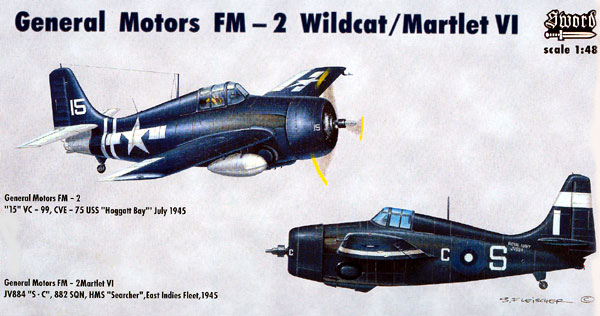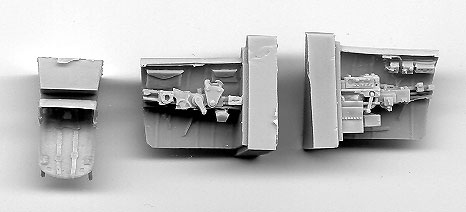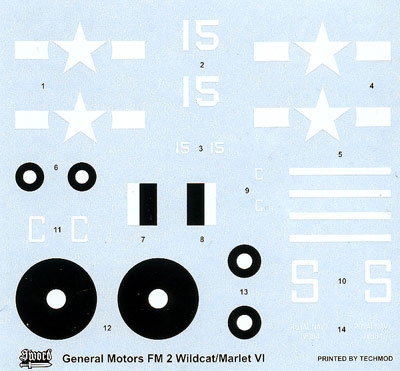|
FM-2 Wildcat/Martlet VI

Sword
S
u m m a r y
|
| Catalogue No. &
Description |
SW48005 |
| Price: |
USD$25.46
from Squadron.com |
| Contents and Media: |
45 injection-moulded parts; three
resin pieces; two vacuformed canopies; decal sheet |
| Scale: |
1/48 |
| Review Type: |
FirstLook |
| Advantages: |
Well detailed; crisply engraved
panel lines; accurate outline; superbly detailed cockpit sidewalls and
seat; two marking choices |
| Disadvantages: |
Somewhat brittle plastic |
| Recommendation: |
Recommended |
Reviewed by
Rodger Kelly

Sword's 1/48
scale FM-2 Wildcat is available online from
Squadron.com
The General Motors FM-2 Wildcat/Martlet VI is Sword’s latest issue in
the company’s foray into 1/48 scale.
It is important to understand that Sword is not a main-line producer and
its products are the result of limited/short-run technology. Having stated
that though, it is hard not to be impressed when you open the box
The kit is packed in cardboard box, but unlike kit boxes from other
manufacturers this one has ends that open rather than a lid that lifts
off. The top and bottom of the box show colour renditions of the options
contained on the decal sheet.
The box contains two sprues consisting of 45 injection-moulded parts in
two different shades of a rather brittle grey plastic, three resin pieces,
two vacuformed canopies, a decal sheet and a set of comprehensive
instructions.
Click the thumbnails below
to view larger images:
The sprue gates are reasonably thick and, as I managed to chip part of the
fuselage when I snipped it from the sprue with scissors, I would recommend
that you use a razor saw to separate the parts from the sprue. The parts
themselves are well moulded and exhibit some very nice detail as well as
small amounts of flash. Don’t be too worried about the flash as it is
easily removed by scraping it away with the back of a hobby knife and with
the use of sandpaper. The only sinkmark that I was able to find was on the
starboard fuselage beneath the horizontal stabilizer, not really a big
deal as it was easily dealt with by the use of a little putty. The
surfaces of the wings and fuselage halves have a slight grain to them but
again, this was easily dealt with by some fine grain sandpaper.
 The three resin parts are the seat and the left and right sides of the
cockpit. These parts are superb as only East European companies seem to be
able to make them. Clean-up will be minimal and restricted to the removal
of the casting blocks and a scrub with a toothbrush in soapy water to
prepare them for painting. The seat has the shoulder and lap belts cast in
place. The three resin parts are the seat and the left and right sides of the
cockpit. These parts are superb as only East European companies seem to be
able to make them. Clean-up will be minimal and restricted to the removal
of the casting blocks and a scrub with a toothbrush in soapy water to
prepare them for painting. The seat has the shoulder and lap belts cast in
place.
Two vacuformed canopies are supplied in the “closed” position. The
canopies are crystal clear and are very close to the standard of those
produced by Falcon for the Squadron canopies range.
Decals are provided for two different aircraft in overall Glossy Sea Blue
(GSB), one for a USN machine and the other for that of the RN Fleet Air
Arm aircraft. The decals are produced by Techmod. My previous experiences
with decal sheets from this company have been positive. They are very
thin, have minimal carrier film and were totally opaque which augers well
for white decals on GSB. Caution is required though as they don’t seem to
like Microset all that much. Ensure you use plenty of water and float the
decal into place and you won’t have any problems. Be wary if opting for
the USN version. The stars and bars are supplied without the blue
border/background. If this is the same aircraft as depicted on page 47 of
the Squadron/Signal In-Action book then it should have the blue
background. Also missing from the sheet is the USN Bureau number for the
fin and all of the other stencil data.

The instruction sheet is pretty comprehensive. It contains a potted
history of the aircraft as well as its tabulated data. The assembly
instructions are depicted in the “exploded view” format and the painting
instructions are by means of a “match the letter to the colour” style.
Also included are comprehensive painting/decal placement instructions with
top and bottom, left and right hand side views of both aircraft.
Click the thumbnails below
to view larger images:
Comparisons and
Conclusion
|
Comparisons to the Tamiya F4F are inevitable so how does it stack up?
Pretty good really. Although a few years old now the Tamiya F4F still
stands out as one of that company’s best products. The surface detail on
the Tamiya kit is littered with tiny rivets. The Sword kit is not. Could
you use the Tamiya detail parts for the Sword kit? Yes you could if you
really wanted to but why bother as the Sword kit parts will look equally
as nice under a coat of paint. The Tamiya rendition is a little sharper in
detail – that’s about it.
The breakdown of parts in the Sword kit also telegraphs a possible issue
of further F4s in the series. Given that it has separate wings suggest
that a-3 with it’s non folding wing could soon appear.
All up, this is a very nice little package and well worth the asking
price. Previously the only way of adding an FM-2 to your collection was by
either modifying the Tamiya F4F-4 with plastic card, filler, elbow grease
and a new propeller or by purchasing the KMC conversion. The Sword issue
now eliminates the need to attack the Tamiya kit.
Recommended.
Review Copyright © 2002 by Rodger
Kelly
Page Created 01 July, 2002
Last updated 22 July, 2003
Back to HyperScale
Main Page
Back to Reviews
Page
|
Home | What's
New | Features
| Gallery |
Reviews | Reference
| Forum
| Search